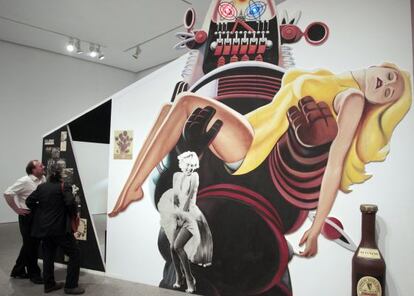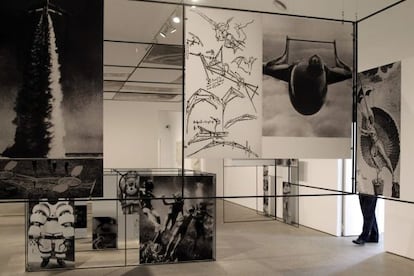An “exhibition of exhibitions” for father of pop art Richard Hamilton
The British artist personally conceived the huge retrospective just opened at Madrid’s Reina Sofía

Richard Hamilton is usually credited with creating pop art, but he was also the forerunner of appropriationism, installation art and many other artistic trends that caught the world by surprise throughout the 20th and early 21st centuries.
Artistically descended from Marcel Duchamp, Hamilton’s work is characterized by irony and playfulness, which form an integral part of his critical reflections and permanent research.
On Friday, Madrid’s Reina Sofía museum opened the most comprehensive retrospective of his oeuvre ever assembled.
Comprising over 270 artworks, it was conceived by the artist himself in 2010, a year before his death. A reduced version of the show opened at London’s Tate Modern last winter, featuring about a third of the works now on display in Madrid.
Besides all of his best-known and most representative work – the cover of The Beatles’ White Album, the celebrity series Swingeing London 67, the Duchamp reproductions, My Marilyn, Interior and The Solomon R. Guggenheim – the Reina Sofía is also showcasing Hamilton’s final work, in which he went back to playing with photography and painting. A 2010 portrait of Tony Blair depicted as a tameless cowboy provides some insight into the corrosive spirit that the artist maintained right up to the end.
Yet the truly major difference between the London and Madrid retrospectives resides in their structure. Reina Sofía director Manuel Borja-Villel explains that the project began to take shape five years ago, when Hamilton visited his museum to reproduce a Duchamp piece, The Large Glass.

“To this great continuator of Duchamp’s work, the creative process mattered more than style,” explains Borja-Villel. “What he was mostly interested in was the event. What he cared about in an exhibition was the concept and its organization. And he wanted this to be an exhibition of exhibitions.”
Following Hamilton’s guidelines, the Reina Sofía reconstructed five large-scale installations: Growth and Form, Lobby, An Exhibit, This is Tomorrow and Man, Machine and Motion.
Curators Vicente Todolí (head of Tate Modern between 2003 and 2010) and Paul Schimmel used 16mm movies screened at the original show and a filmed tour of that exhibition. The Madrid show is therefore doubly interesting in that it represents Hamilton’s dream exhibition, as well as demonstrating how the artist found inspiration in the sensibilities of Surrealism and Dadaism, the literary techniques of James Joyce and the artistic language of Duchamp.
Showing no particular interest in chronological order, the curators divided the exhibition into 14 sections covering every field and material in which Hamilton worked between 1949 and 2011. It begins with his early painting, which addresses alterations to organic matter, and moves on to his arch-famous pop art, reminiscent of later work by the likes of Andy Warhol and Roy Lichtenstein.
A version of the collage Just what is it that makes today’s homes so different, so appealing? is the centerpiece of This Is Tomorrow, the 1956 show that invited artists, architects and designers to work on a single project together. The poster for the show was the aforementioned collage depicting a body builder, a topless woman and neon lights in a setting filled with modern gadgets. It was the official beginning of the pop movement.
A 2010 portrait of Tony Blair shows the corrosive spirit Hamilton maintained to the end
But one of the most eye-catching recreations is based on the 1957 An Exhibit, in which Hamilton manifested his esthetic and conceptual concerns at the time. What mattered here was structure and Hamilton tried to get the public involved through his use of methacrylate panels.
It is curious to view the portraits he created of many celebrities in 1960s London, or the Polaroid shots of himself that he asked others to take. There are 128 images taken by famous friends of his, ranging from Francis Bacon to Andy Warhol, Man Ray, Yoko Ono and even Catalan chef Ferran Adrià.
One of his last works on display is a titleless piece inspired by French writer Honoré de Balzac’s The Unknown Masterpiece, the story of a painter who is obsessed with creating the perfect feminine nude. Together with the reclining woman, Hamilton incorporates self-portraits by Poussin, Courbet and Titian, three artists in a permanent struggle to master the female nude.
The artist Rita Donagh, who was Hamilton’s partner for most of his life, smiled with satisfaction as she inspected the rooms of the Reina Sofía on opening day. Beforehand she had thanked organizers for recreating what could well be considered the artistic legacy of Richard Hamilton.
Tu suscripción se está usando en otro dispositivo
¿Quieres añadir otro usuario a tu suscripción?
Si continúas leyendo en este dispositivo, no se podrá leer en el otro.
FlechaTu suscripción se está usando en otro dispositivo y solo puedes acceder a EL PAÍS desde un dispositivo a la vez.
Si quieres compartir tu cuenta, cambia tu suscripción a la modalidad Premium, así podrás añadir otro usuario. Cada uno accederá con su propia cuenta de email, lo que os permitirá personalizar vuestra experiencia en EL PAÍS.
¿Tienes una suscripción de empresa? Accede aquí para contratar más cuentas.
En el caso de no saber quién está usando tu cuenta, te recomendamos cambiar tu contraseña aquí.
Si decides continuar compartiendo tu cuenta, este mensaje se mostrará en tu dispositivo y en el de la otra persona que está usando tu cuenta de forma indefinida, afectando a tu experiencia de lectura. Puedes consultar aquí los términos y condiciones de la suscripción digital.
Últimas noticias
Maduro pleads not guilty before the federal court in New York: ‘I am still the president of Venezuela’
A new test can detect Alzheimer’s from a finger prick
UN team enters Sudanese city of El Fasher after paramilitary massacre: ‘It’s like a ghost town’
A recipe for resistance: Indigenous peoples politicize their struggles from the kitchen
Most viewed
- Gilles Lipovetsky: ‘If you want to live better and fall in love, take Prozac, don’t look to philosophy’
- Alain Aspect, Nobel laureate in physics: ‘Einstein was so smart that he would have had to recognize quantum entanglement’
- Alvin Hellerstein, a 92-year-old judge appointed by Bill Clinton, to preside over Maduro’s trial in New York
- Why oil has been at the center of Venezuela-US conflicts for decades
- Cuba confirms death of 32 of its citizens in the US attack against Venezuela








































